German Argentines
German Argentines (German: Deutschargentinier, Spanish: germano-argentinos) are Argentine citizens of German ancestry. They are descendants of Germans who immigrated to Argentina from Germany and elsewhere in Europe. Some German Argentines originally settled in Brazil, then later immigrated to Argentina. Germany as a political entity was founded only in 1871, but immigrants from earlier dates are also considered German Argentines due to their shared ethnic heritage, language and culture. German Argentines today make up the fourth-largest ethnic group in Argentina, with over two million Volga Germans alone.[1]
| |
|---|---|
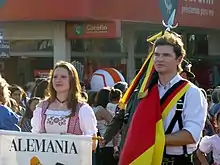 German Argentines during the Immigrant's Festival in Oberá, Misiones. | |
| Total population | |
| More than 3.5 million (descendants of German citizens: 1 million) | |
| Regions with significant populations | |
| Córdoba, Buenos Aires, Buenos Aires Province, Entre Ríos, La Pampa Province, Río Negro Province, Misiones, Chaco, Santa Fe, Neuquén. | |
| Languages | |
| Rioplatense Spanish · German and German dialects | |
| Religion | |
| Roman Catholicism · Protestantism (Lutheranism · Evangelicalism) · Judaism |
German Argentines have founded German schools such as the Hölters Schule and German-language newspapers such as the Argentinisches Tageblatt ("Argentine Daily").[2] The five provinces with the largest numbers of inhabitants of German descent are, in order of largest German population: Córdoba, Entre Ríos, Buenos Aires, Misiones and La Pampa.
German immigration to Argentina
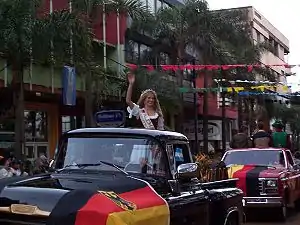
Between 1885 and World War I the population of Argentina doubled due to an influx of three million European immigrants, 100,000 of whom spoke German. German communities developed in many areas, especially Buenos Aires, with their own schools, hospitals, shops, theaters, sports clubs, and banks. Many of those who immigrated directly from Germany were assimilated into the upper-middle class of Buenos Aires, but maintained strong ties to German culture, providing their children with a German education so they would not be at a disadvantage if they returned to Germany.
.svg.png.webp)
German immigration to Argentina occurred during five main time periods: pre–1870, 1870–1914, 1918–1933, 1933–1940 and post–1945. In the first period numbers were generally low; of note are the colonias alemanas, first founded in the province of Buenos Aires in 1827. During the second period, Argentina experienced a boom in immigration due to massive economic expansion in the port of Buenos Aires and the wheat and beef producing Pampas. German immigrants began establishing themselves and developing newspapers, schools, and social clubs. A new, Germanic-Argentine identity gradually developed among the population.
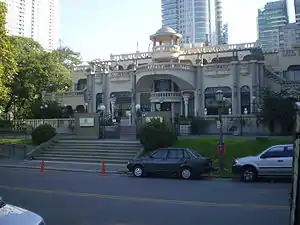
During the third period, after a pause due to World War I, immigration to Argentina resumed and German speakers came in their largest numbers. This can be attributed to increased immigration restrictions in the United States and Brazil as well as the deteriorating conditions in post-World War I Europe. The two largest years of German immigration to Argentina were 1923 and 1924, with approximately 10,000 each year. This period is of particular interest because the older groups of German speakers began to feel a sense of cultural crisis due to the assimilation policies of the Argentine state, while the newcomers gave renewed life to German cultural institutions and created new ones. Between 1905 and 1933, the number of German schools rose from 59 to 176. Though found throughout Argentina, over 80% of these were located in Buenos Aires, Misiones, or Entre Ríos in 1933. Further, attendance at German schools rose from 3,300 in 1905 to 12,900 in 1933. Studies of this period inherently favor Buenos Aires, where half of all Germans lived, over the colonias, where fewer institutions (particularly newspapers) developed.
During the penultimate period, from 1933 to 1940, Argentina experienced another surge in German immigration. The majority were German Jews although other German opponents of Nazism also arrived. Half of the 45,000 German speakers who immigrated at this time settled in Buenos Aires. They comprised 28% of total immigration to the country, as mass migration to Argentina was slowing. Two studies have been done on these arrivals’ impact on the newspaper Das Argentinische Tageblatt and how it was used by anti-Nazi immigrants to contribute to the debate about fascism.
The final period of German immigration to Argentina occurred between 1946 and 1950 when President Juan Perón ordered the creation of a ratline for prominent Nazis, collaborators and other fascists from Europe. During this period, Argentine diplomats and intelligence officers, on Perón's instructions, vigorously encouraged these groups to make their home in Argentina.
The country received 12,000 immigrants from Germany between 1946 and 1952, a smaller number than in previous periods. This meant that the concepts of acculturation and linguistic and cultural persistence were not dealt with in the same way. The group did not congregate as tightly and participated more in general culture. Further, because of an era of national identities and the post-World War II problems of promoting German identity, the pre-existing process of assimilation was not met with resistance by the new arrivals.[3]
Volga German immigration to Argentina
.svg.png.webp)
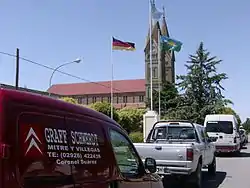

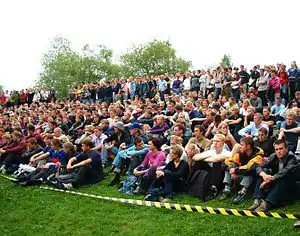


Upon the invitation of Catherine the Great, 25,000 Germans immigrated to the Volga valley of Russia to establish 104 German villages from 1764 to 1767. A century after the first Germans had settled in the Volga region, Russia passed legislation that revoked many of the privileges promised to them by Catherine the Great. The sentiment in Russia became decidedly anti-German. Russia first made changes to the German local government. In 1874, a new military law decreed that all male Russian subjects, when they reached the age of 20, were eligible to serve in the military for 6 years. For the German colonists, this law represented a breach of faith. In the 1880s the Russian government began a subtle attack on the German schools.
Just when Russia was abridging the privileges granted to the Germans in an earlier era, several nations in the Americas were attempting to attract settlers by offering inducements reminiscent of those of Catherine the Great. Soon after the military service bill became law, both Protestant and Catholic Volga Germans gathered and chose delegations to journey across the Atlantic to examine settlement conditions in countries like the United States, Argentina, Brazil, and Canada.
Many Catholic Volga Germans chose South America as their new homeland because the official religion in Brazil and Argentina was Roman Catholic. The ratio of Catholic to Protestant Volga Germans in South America was 7 to 1. The opposite was true in Russia, Protestant Volga Germans outnumbered Catholics by about 2 to 1. So despite the numerous stories told of Volga German immigrants being diverted to South America against their will or being sent there because they were denied entry to the US due to health reasons, Brazil and Argentina were the planned destination of many Catholic Volga German immigrants.
Under the guidance of Andreas Basgall, Volga Germans started to relocate to Argentina from Brazil in December 1877, and in January 1878 they founded the first Volga German colony of Hinojo, in the province of Buenos Aires. Some large groups of Volga Germans on ships destined for Brazil were diverted to Argentina. These people settled in Colonia General Alvear in the province of Entre Ríos. Additional Volga Germans, some from Brazil and others directly from Russia, arrived in Argentina over the next few years. Colonia General Alvear was for many years the main settlement of Volga Germans in Argentina. Nearly 90% of the first Volga Germans who arrived in Argentina settled there.
The first census of the Volga Germans in Argentina was performed on March 31, 1881, in "Colonia General Alvear", Entre Rios Province. A complete census index of all the villages within the colony villages can be found here . This colony was composed of 6 villages: Asunción (Spatzenkutter), Concepción (Valle María), San José (Brasilera), Agricultores (Protestante), San Francisco (Pfeiffer), and Salto (Koeller). This census provides the Date of arrival in the Colony (24 groups between 22 and 01-1878 and 24-04-1880), Name, Nationality, Marital status, age, and literacy. Five of six villages were Catholic. The single Lutheran village was Agricultores (Protestante or Protestantendorf).
From both starting points of Colonia General Alvear and of Colonia Hinojo they spread in all directions. There are still fifteen villages in Entre Ríos populated by descendants of the original settlers, twelve of them are of Catholic origin, and the remaining three, Protestant. However, most Volga Germans live in small cities like Ramírez, Crespo, Urdinarrain, Galarza, and Maciá where they usually are the majority. Expansion from Colonia Hinojo went westwards comprising south of Buenos Aires and the province of La Pampa; from there they reached Córdoba and Chaco. Catholic settlers in La Pampa came from south of Buenos Aires and Protestants from Entre Ríos. The former founded Santa María and Santa Teresa, the latter Guatraché, San Martín, and Alpachiri. Source: "Los Alemanes del Volga" 1977 Victor Popp - Nicolás Dening.
Upon arriving in Argentina, the Volga German families were very happy even though they had to begin from scratch because they were finally living in freedom. In contrast to their Volga German countrymen in Russia, they would never be exiled, they did not experience famines like those of 1921 and 1933 in the Volga region nor any mass shootings and deportation as under Stalin's regime. Finally, they were never dispossessed, they kept their land and their animals – something they remain proud of to this day. The immigration of Germans from Russia to Argentina kept a steady pace until the beginning of World War I. Crespo in Entre Ríos Province and Coronel Suárez in Buenos Aires Province became the most outstanding centers of colonization, as in both cities people of Volga German descent make up the majority of the population. At present, the descendants of these people live disseminated all over Argentina. The numerous progeny of the founders and the division and distribution of their properties into smaller lots forced many of them to abandon the original colonization sites and find new occupations.
The fact that Argentina appears among the most important grain producers of the world is, in part, the responsibility of its citizens of Volga German origin.
Today the Volga-German population alone in Argentina is well over 2 million.
Historical ties with Argentina and Germany
Argentina and Germany had close ties to each other since the first wave of German emigration to Argentina. A flourishing relationship developed between Germany and Argentina as early as the German Unification, with Germany eventually coming to hold a privileged position in the Argentine economy. Later on, Argentina maintained a strong economic relationship with both Imperial Germany and the British Empire, supporting both their wartime economies with supply shipments during World War I.
The military connection between Argentina and Prussia has often been emphasized, and sympathy for Germany among the general staff in Buenos Aires contributed to establishing Argentina's policy of neutrality during the First and Second World Wars. From the point of view of Argentine strategists at the end of the nineteenth century, it was a clever move to fall in line with the strongest European war machine. Great Britain and the United States became aware of the threat that Argentina's German-speakers, which were a quarter-million strong, acted as the Reich's agent. Many Argentines voiced open support for Nazi Germany.
After World War II, under Juan Perón's administration, Argentina participated in establishing and facilitating secret escape routes out of Germany to South America for ex-SS officials (the ODESSA network)[4] Former Nazi officials emigrated to Argentina in order to prevent prosecution. Some of them lived in Argentina under their real names, but others clandestinely obtained new identities. Some well-known Nazis that emigrated to Argentina are Obersturmbannführer Adolf Eichmann, Nazi doctors Josef Mengele and Aribert Heim, Commander Erich Priebke, Commandant Eduard Roschmann, and General Lieutenant "Bubi" Ludolf von Alvensleben.
German impact on culture in Argentina
Food
The influence of German culture has also influenced Argentine cuisine; the "Achtzig Schlag" cake, which was translated as Torta Ochenta Golpes in the country, can be found in some bakeries. In addition, dishes like chucrut (sauerkraut) and many different kinds of sausage-like bratwurst and others have also made it into mainstream Argentine cuisine.
Language
Today, most German Argentines do not speak German at home because of the decline of the language; however, some estimates suggest that 1.8 million Argentines of non-German descent have some knowledge of German.[5] It is a language that can be heard all over the country, and this is partly maintained by the continued existence of German-speaking Argentines and some business connections. It is currently the fifth most spoken language in Argentina.
German colonies in Argentina
This is not an exhaustive list.
Buenos Aires Province
- Colonia Hinojo (5 January 1878) - originally called Colonia Santa María and called "Kamenka" by the Colonists (named after several Volga German towns in Russia). It is situated in Olavarría Partido.
- Colonia Monte La Plata (1906)
- Colonia Nievas (1885) - called Holtzel by the colonists.
- Colonia San Miguel (3 October 1881) - called Dehler by settlers.
- Colonia Santa Rosa (1899).
- Colonia San Miguel Arcangel (1903).
- Coronel Suárez (1883).
- San José (1887) - called Dehler by the colonists and situated in Coronel Suárez Partido.
- Santa Trinidad (1887) - called Hildmann by the colonists and situated in Coronel Suárez Partido.
- Santa María (1887) - called Kamenka by the colonists and situated in Coronel Suárez Partido.
- Sierra de La Ventana (1908)
- Stroeder
- Tornquist (1883)
- Villa Gesell (1931)
- Verónica
Entre Ríos Province
- Crespo, Entre Ríos
- Colonia General Alvear (1878), includes the following 5 hamlets:
- Aldea Valle María (Mariental)
- Aldea Spatzenkutter
- Aldea Salto (Kehler) or Santa Cruz
- Aldea San Francisco (Pfeiffer)
- Aldea Protestante
- Aldea Brasilera (1879)
- Aldea María Luisa (1883)
- Aldea San Juan (1889)
- Aldea San Antonio (1889)
- Aldea Santa Celia (1889)
- Aldea San Miguel (1899)
- Aldea Santa Anita (1900)
- Aldea San Isidro (1921)
- Villa Paranacito (1906)
Córdoba Province
- Colonia Santa María
- Colonia San José
- Colonia Eldorado
- Villa General Belgrano (1930)
- La Cumbrecita
- Villa Berna
- Villa Alpina
- Villa María (with Italian and English immigrants)
- Colonia Bismarck
- Colonia Bremen
- Corral de Bustos
- Silvio Pellico (with Italian immigrants)
La Pampa Province
- Colonia Santa María (1909)
- Alpachiri (1910)
- Colonia San José (1910)
- Colonia Barón (1915)
- Winifreda (1915)
- Colonia Santa Teresa (1921)
Chaco Province
- Juan José Castelli
- La Florida
Santa Fe Province
- Colonia Esperanza (Swiss German)
- Colonia San Carlos (Swiss German)
- Colonia San Jerónimo/San Jerónimo Norte (Swiss German)
- Gödeken
Neuquén Province
- Villa La Angostura
- Villa Traful (1936)
- San Martín de los Andes (1898)
Río Negro Province
- San Carlos de Bariloche (1895)
- Puerto Blest
- Colonia Paso Flores
- Colonia Suiza (Swiss German)
Misiones Province
- Eldorado (1919)
- Puerto Rico (founded by Catholic ethnic Germans recorded as Brazilian citizens when came to Argentina)
- Montecarlo (founded by Protestant ethnic Germans recorded as Brazilians when came to Argentina)
- Comandante Andresito
- Oberá
- Bonpland
Quilmes
Cervecería y maltería or Quilmes Beer Company is an Argentine Brewery founded in 1888 in Quilmes, Buenos Aires Province, by Otto Bemberg, a German immigrant. His great-granddaughter María Luisa Bemberg took over the company until she died in 1995 and her son, Carlos Miguens Bemberg was the director from 1989 until his resignation on May 17, 2006.
San Carlos de Bariloche
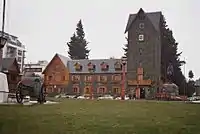
Like many cities settled by Germans, its development was greatly influenced by them and today the city has many examples of Chalet-style architecture brought by German, Swiss and Austrian immigrants. It was named after Carlos Weiderhold, a German Chilean from the city of Osorno who pioneer who settled the region, and the city has become one of Argentina's top tourist destinations.
Figures
Population of German descent by province1 - Córdoba 1.000.000 2 - Buenos Aires Province 425.000 3 - Entre Rios 350.000 4 - Misiones 325.000 5 - Buenos Aires 300.000 Other provinces: 600,000 EducationGerman schools:[7]
Historic German schools:[8]
Famous German-ArgentinesThis is not an exhaustive list.
See alsoReferences
Bibliography
External links | |||||||||||||||||||||||||||||||||||||||||||||||||||||||||||||||||||||
